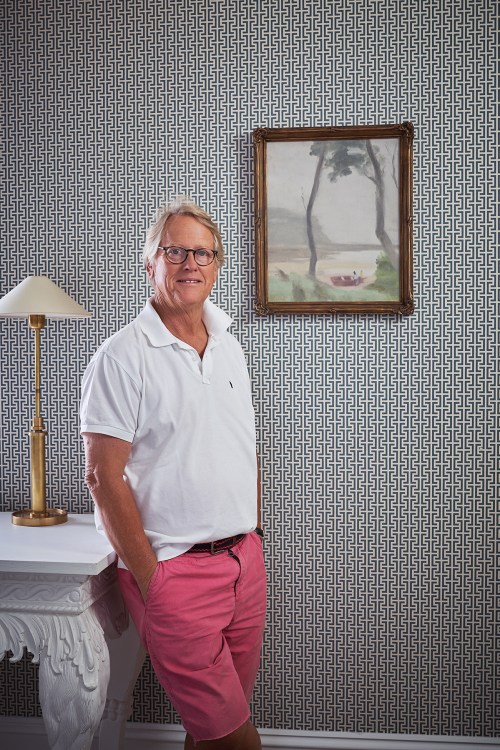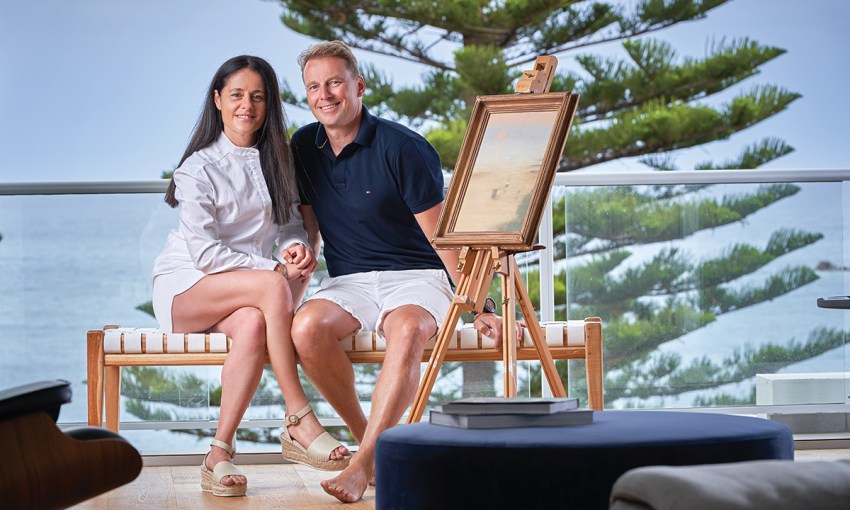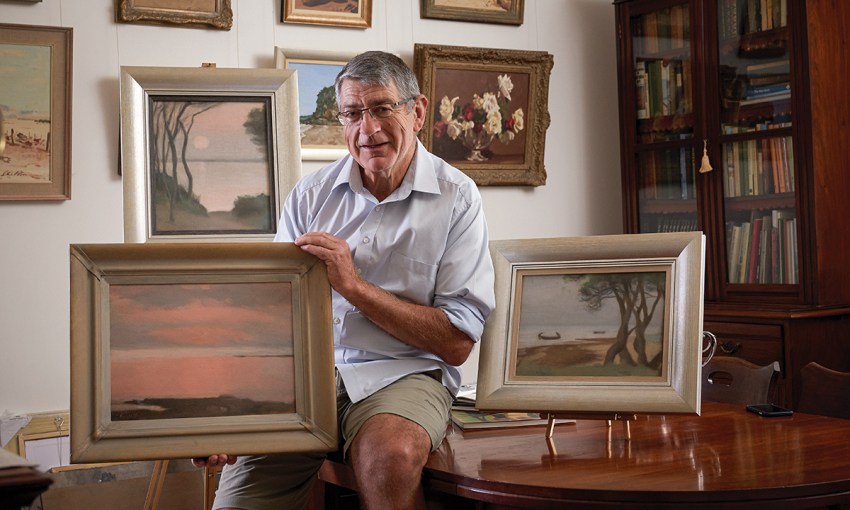There’s an ethereal, mystical quality to artist Clarice Beckett’s work that casts a spell over art lovers, including these South Australians who have loaned their treasured paintings for a major new exhibition at the Art Gallery of SA.
Clarice Beckett: See the light
“It’s about that light,” says Roscoe Shelton, explaining why he loves Clarice Beckett’s paintings.
“That half-light at the very end of the day or the very beginning of the morning, and the mistiness that comes through … the best sunrises and sunsets, they’re fleeting.”
Roscoe first saw the Australian painter’s work at a 1971 exhibition in Melbourne presented by researcher and former gallery owner Dr Rosalind Hollinrake, who is credited with rediscovering Clarice after she vanished from art history for several decades following her death in 1935. Rosalind presented two exhibitions in the early ’70s after a chance meeting with Clarice’s sister Hilda led her to salvage hundreds of neglected canvases from a remote shed in rural Victoria.
Back then, Roscoe was a 21-year-old engineering student and had begun collecting a few paintings. Like Clarice, his father had been a student of artist and teacher Max Meldrum and Roscoe knew Max’s daughters Ida and Elsa, so he sought their advice on Clarice’s work before reaching into his pocket.
“The Clarice Beckett paintings were paintings that I could afford,” he says, recalling that he paid just $140 for the first one.
Today, Roscoe, now retired, owns three Beckett paintings, all of which were bought in the 1970s and are on loan to the Art Gallery of South Australia for its exhibition Clarice Beckett: The Present Moment.
One of the paintings – Early morning, fishing – hasn’t been publicly exhibited in 50 years. The two others, Sunset and Sunset on the Bay, capture fading light at Victoria’s Port Phillip Bay. Exhibition curator Tracey Lock describes Clarice’s series of sunsets as “among the most sublime statements in Australian landscape art”.
Although he’s made some astute acquisitions, Roscoe says his art purchases are driven by love for an artwork rather than investment potential. He and wife Jillian’s Adelaide home is full of paintings – including a Max Meldrum and works by his father and other Meldrum students – and as he speaks about art, he points out the commonalities and contrasts between different artists and their techniques.
In recent years, Roscoe has also started painting himself, and when trying to perfectly capture a scene – especially the shifting light – he finds motivation in Clarice’s work.
“Clarice Beckett has captured what I call the very essence of those evening lights and those morning lights, and no one else really does that to the skill level that she’s done. She’s taken the skill of that Meldrum school and delivered the outcome that everyone aspires to.”
Her work, he adds, is even more impressive given that she was painting en plein air in the 1920s and ’30s: “In today’s era, people take photographs and take them home and paint them; in that era, it would be really quite a rapid paint because they had to capture it at the moment. So when you look at the detail of what Clarice has done, it is remarkable.”

The Art Gallery of South Australia considers Clarice Beckett one of this country’s finest painters of the 20th century. The Present Moment is the most comprehensive retrospective of her work ever staged, with nearly 130 of her paintings of everyday scenes and nature presented in a way that charts the chronology of a single day, from sunrise to nightfall.
The works include many of those salvaged by Rosalind Hollinrake and paintings drawn from national public collections as well as 35 private lenders, including 11 from South Australia.
Another of the South Australian lenders is Robert Hill-Smith, of Yalumba Wines, who bought the painting Early morning (The fishermen) at auction in Melbourne in 2016 after following Clarice Beckett’s art for some time.
“One of my passions is impressionism and although her style is technically not impressionism, it is to me a form of post-impressionism, I suppose, because of the tones and light and really the inspirations behind her work,” Robert says.
Early morning (The fishermen) usually hangs in a bedroom of Robert and wife Annabel’s North Adelaide home, and there’s an ethereal feel to the misty scene that he finds particularly soothing.
“It was very symptomatic of her best-known style. It’s so genteel and mystical and yet has these little tonal highlights that really attracted me to it. The scene in general is quite typical of many of her works. I imagine this will be one of three that I will acquire; I’ve got three children.”
Robert and Annabel describe themselves as art lovers or buyers, rather than collectors, with works by contemporary artists such as Tamara Dean, Garry Shead and Trent Parke also on display in their home. Two of Robert’s favourite impressionist artists are Monet and the eccentric Toulouse-Lautrec; he has two Toulouse-Lautrec lithographs, and comments that when acquiring works an art lover is also buying into an artist’s history and evolution.
“I was reading about Clarice Beckett the other day and someone’s referred to her as a latter-day Monet or Monet’s daughter … I love the way she evolved. I love [Frederick] McCubbin and she studied under McCubbin and Max Meldrum.
“I think, in terms of her importance in Australian art and art history, that she should enjoy a little more national recognition than she’s had to date.”
In the catalogue accompanying The Present Moment, Tracey Lock writes that following her death from double pneumonia at the age of 48, Clarice was “almost completely forgotten, as though extinguished like the flame of a candle” before Rosalind’s work led to her recognition as a major force in Australian modernism.
Although Clarice’s work was admired by some circles and exhibited during her lifetime, it is also said to have been misunderstood. Despite this and other challenges, she continued to paint prolifically, capturing landscapes and vistas near her family home in the Melbourne bayside suburb of Beaumaris – from beach scenes to cityscapes, such as trams on St Kilda Road.
The story of Clarice’s life and career has enhanced the appreciation Alexandra Dimos and Andrew Nunn have for the painting they have loaned for the retrospective exhibition.
Alexandra and Andrew, both environmental engineers who live in Adelaide with their two children, have a family philanthropic foundation (the Nunn Dimos Foundation) that supports a broad range of South Australian organisations and causes, including in the arts sector. When they wanted to further their knowledge of visual art and start purchasing pieces for their home, they sought guidance from Peter Walker of Peter Walker Fine Art, who introduced them to the paintings of Clarice Beckett.

One of the early paintings they bought was Beach at sunset. Painted by Clarice on Victoria’s Bellarine Peninsula circa 1931, it shows a pair of figures beside a boat on the beach and struck a chord with the couple, who are originally from Victoria.
“When we purchased this piece we found out a bit about the painter,” Alexandra says. “I’ve started getting more and more into Clarice and learning about her story – she’s just absolutely fascinating. We look at it now, and we appreciate it even more so than before.
“When I look at her I think about the time out that she took for herself, to go out there and paint. I admire the fact that she was so passionate; she went and studied, she just pushed through all those boundaries.”
“She was quite entrepreneurial,” adds Andrew, who was recently appointed SA’s new Chief Entrepreneur. “Not commercially entrepreneurial, but entrepreneurial in the sense of an entrepreneur being someone with a passion who pushes through when everyone says no, it can’t be done; she did that beautifully and she just kept pushing. She did it her way.”
The walls of the couple’s house are now hung with an eclectic collection of striking artworks from artists they admire, including Michael Zavros, Dorrit Black and Peter Drew. It’s a beautiful, light-filled home with walls made for art, but Andrew admits he tried hanging Beach at sunset in a number of different places before settling on the perfect spot: a living room wall where it catches the afternoon sun and can be seen all the time, including while enjoying a coffee at the kitchen island.
“I see it a hundred times a day and I often sit and look at it -– I really like it,” he says. For him, the painting evokes “quiet time”: “It’s a reflective moment as the sun goes down. You’re looking at the back of someone’s head as they watch the sun go down, that’s how I see it, and it is relaxing.”
Like Robert Hill-Smith, Alexandra and Andrew would love to add more Clarice Beckett paintings to their collection.
“All her work, even the trams, is so peaceful; it’s just a moment in time through her lens,” Alexandra says. “I’m really pleased that the art gallery is celebrating this lady.”
Clarice Beckett: The Present Moment is at the Art Gallery of South Australia until May 23.
This story was first published in the April 2021 issue of SALIFE magazine.



